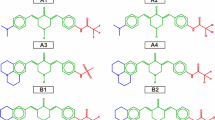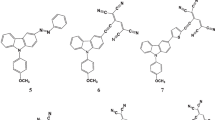Abstract
In the present work, we have synthesized novel D–π–A substituted bis-1,3,4-oxadiazoles derivatives and studied nonlinear optical properties using density functional theory (DFT). The FT-IR and 1H NMR data confirmed the structure of the molecule. The HOMO–LUMO, energy band gap, molecular electrostatic potential map, and global chemical reactivity descriptors were estimated using the DFT and TD-DFT with B3LYP, CAM-B3LYP and WB97XD using 6-31G (d) levels basis set and results show all synthesized molecules have excellent chemical hardness, chemical potential, excellent chemical strength, and excellent chemical stability. The static and dynamic linear polarizability, first hyperpolarizability and second hyperpolarizability components were estimated using time-dependent density functional theory. The first-order hyperpolarizability β (2x; x, x) computed at a wavelength of 1064 nm was found to be 55 times greater than the urea molecule. The dynamic molecular second-order hyperpolarizabilities γ (−3x;x,x,x) suggested good nonlinear properties for the designed molecule.



Similar content being viewed by others
Availability of data and materials
All data set can be accessed. Appropriate permission for images is given.
References
S. Dawbaa, D. Nuha, A.E. Evren, M.Y. Cankiliç, L. Yurttaş, G. Turan, New oxadiazole/triazole derivatives with antimicrobial and antioxidant properties. J. Mol. Struct.Struct. 1282, 135213 (2023). https://doi.org/10.1016/j.molstruc.2023.135213
K.K. Jha, A. Samad, Y. Kumar, M. Shaharyar, R.L. Khosa, J. Jain, P. Singh, Design, synthesis and biological evaluation of 1, 3, 4-oxadiazole derivatives. Eur. J. Med. Chem. 45(11), 4963–4967 (2010). https://doi.org/10.1016/j.ejmech.2010.08.003
M.M.S. Hamoud, N.A. Osman, S. Rezq, H.A.A. Abd El-wahab, A.E.A. Hassan, H.A. Abdel-Fattah, D.G. Romero, A.M. Ghanim, Design and synthesis of novel 1,3,4-oxadiazole and 1,2,4-triazole derivatives as cyclooxygenase-2 inhibitors with anti-inflammatory and antioxidant activity in LPS-stimulated RAW264.7 macrophages. Bioorg. Chem.. Chem. 124, 105808 (2022). https://doi.org/10.1016/j.bioorg.2022.105808
B.W. Matore, P. Banjare, T. Guria, P.P. Roy, J. Singh, Oxadiazole derivatives: Histone deacetylase inhibitors in anticancer therapy and drug discovery. Eur. J. Med. Chem. Rep. 5, 100058 (2022). https://doi.org/10.1016/j.ejmcr.2022.100058
G. Grover, R. Pal, R. Bhatia, M.S. Yar, R. Nath, S. Singh, K. Raj, B. Kumar, M.J. Akhtar, Design, synthesis, and pharmacological evaluation of aryl oxadiazole linked 1,2,4-triazine derivatives as anticonvulsant agents. Med. Chem. Res. 31, 781 (2022). https://doi.org/10.1007/s00044-022-02880-4
Y. Dai, J.A. Santiago-Rivera, S. Hargett, J.M. Salamoun, K.L. Hoehn, W.L. Santos, Conversion of oxadiazolo[3,4-b]pyrazines to imidazo[4,5-b]pyrazines via a tandem reduction-cyclization sequence generates new mitochondrial uncouplers. Bioorg. Med. Chem. Lett.. Med. Chem. Lett. 73, 128912 (2022). https://doi.org/10.1016/j.bmcl.2022.128912
S. Baykov, A. Semenov, M. Tarasenko, V.P. Boyarskiy, Application of amidoximes for the heterocycles synthesis. Tetrahedron Lett. 61, 152403 (2020). https://doi.org/10.1016/j.tetlet.2020.152403
N.M. Aljamali, Survey on methods of preparation and cyclization of heterocycles. Int. J. Chem. Mol. Eng. 6(2), 19–36 (2020)
Q. Bian, C. Wu, J. Yuan, Z. Shi, T. Ding, Y. Huang, H. Xu, Y. Xu, Iron nitrate-mediated selective synthesis of 3-Acyl-1,2,4-oxadiazoles from alkynes and nitriles: the dual roles of iron nitrate. J. Org. Chem. 85, 4058 (2020). https://doi.org/10.1021/acs.joc.9b03070
M.S. Thippeswamy, L. Naik, C.V. Maridevarmath, G.H. Malimath, A comprehensive studies on photophysical and electrochemical properties of novel D-π-A thiophene substituted 1,3,4-oxadiazole derivatives for optoelectronic applications: a computational and experimental approach. Chem. Phys. 550, 111301 (2021). https://doi.org/10.1016/j.chemphys.2021.111301
M.C. Scharber, N.S. Sariciftci, Low band gap conjugated semiconducting polymers. Adv. Mater. Technol. 6, 2000853 (2021). https://doi.org/10.1002/admt.202000857
Y.N. Luponosov, J. Min, A.N. Solodukhin, O.V. Kozlov, M.A. Obrezkova, S.M. Peregudova, T. Ameri, S.N. Chvalun, M.S. Pshenichnikov, C.J. Brabec, S.A. Ponomarenko, Effects of electron-withdrawing group and electron-donating core combinations on physical properties and photovoltaic performance in D-π-A star-shaped small molecules. Org. Electron. 32, 157 (2016). https://doi.org/10.1016/j.orgel.2016.02.027
J. Min, Y.N. Luponosov, C. Cui, B. Kan, H. Chen, X. Wan, C.J. Brabec, Evaluation of electron donor materials for solution-processed organic solar cells via a novel figure of merit. Adv. Energy Mater. 7(18), 1700465 (2017). https://doi.org/10.1002/aenm.201700465
Z. Qin, C. Gao, W.W. Wong, M.K. Riede, T. Wang, H. Dong, W. Hu, Molecular doped organic semiconductor crystals for optoelectronic device applications. J. Mater. Chem. C 8(43), 14996–15008 (2020). https://doi.org/10.1039/d0tc02746d
S.H. Lee, B.J. Kang, J.S. Kim, B.W. Yoo, J.H. Jeong, K.H. Lee, M. Jazbinsek, J.W. Kim, H. Yun, J. Kim, Y.S. Lee, F. Rotermund, O.P. Kwon, New acentric core structure for organic electrooptic crystals optimal for efficient optical-to-THz conversion. Adv. Opt. Mater. 3, 756 (2015). https://doi.org/10.1002/adom.201400502
R.N. Rai, K.B.R. Varma, Growth and characterization of single crystal of pentachloropyridine. J. Cryst. GrowthCryst. Growth. 285, 111 (2005). https://doi.org/10.1016/j.jcrysgro.2005.08.012
V. Crasta, V. Ravindrachary, S. Lakshmi, S.N. Pramod, M.A. Shridar, J.S. Prasad, Growth, characterization and crystal structure analysis of 1-(4-chlorophenyl)-3-(4-chlorophenyl)-2-propen-1-one. J. Cryst. GrowthCryst. Growth (2005). https://doi.org/10.1016/j.jcrysgro.2004.10.110
S.H. Lee, M. Jazbinsek, C.P. Hauri, O.P. Kwon, Recent progress in acentric core structures for highly efficient nonlinear optical crystals and their supramolecular interactions and terahertz applications. CrystEngComm 18(38), 7180–7203 (2016). https://doi.org/10.1039/c6ce00707d
X. Liu, Z. Yang, D. Wang, H. Cao, Molecular structures and second-order nonlinear optical properties of ionic organic crystal materials. Crystals 6, 158 (2016). https://doi.org/10.3390/cryst6120158
M. Imran, M. Khalid, R. Jawaria, A. Ali, M.A. Asghar, Z. Shafiq, A.A.C. Braga, Exploration of photophysical and nonlinear properties of salicylaldehyde-based functionalized materials: a facile synthetic and DFT approach. ACS Omega 6(49), 33914–33922 (2021). https://doi.org/10.1021/acsomega.1c04984
S. Aslam, M. Haroon, T. Akhtar, M. Arshad, M. Khalid, Z. Shafiq, M. Imran, A. Ullah, Synthesis, characterization, and DFT-based electronic and nonlinear optical properties of methyl 1-(arylsulfonyl)-2-aryl-1H-benzo[d]imidazole-6-carboxylates. ACS Omega 7, 31036 (2022). https://doi.org/10.1021/acsomega.2c02805
N. Arif, Z. Shafiq, S. Noureen, M. Khalid, A. Ashraf, M. Yaqub, S. Irshad, M.U. Khan, M.N. Arshad, A.A. Carmo Braga, A.H. Ragab, S.R. Al-Mhyawi, Synthesis, spectroscopic, SC-XRD/DFT and non-linear optical (NLO) properties of chromene derivatives. RSC Adv. 13, 464 (2022). https://doi.org/10.1039/d2ra07134g
N. Kaippamangalath, U. Gopalakrishnapanicker, Synthesis and evaluation of properties of poly(p-phenylenevinylene) based 1,3,4-oxadiazole systems for optoelectronics and nonlinear optical applications. Polym. Int.. Int. 65, 1221 (2016). https://doi.org/10.1002/pi.5183
M. Homocianu, A. Airinei, C. Hamciuc, A.M. Ipate, Nonlinear optical properties (NLO) and metal ions sensing responses of a polymer containing 1,3,4-oxadiazole and bisphenol A units. J. Mol. Liq. 281, 141 (2019). https://doi.org/10.1016/j.molliq.2019.02.065
M.S.S. Oliveira, A.B.S. Santos, T.V.B. Ferraz, G.L.C. Moura, E.H.L. Falcão, Non-symmetrical 1,3,4-oxadiazole derivatives: synthesis, characterization, and computational study of their optical properties. Chem. Phys. Impact 6, 100162 (2023). https://doi.org/10.1016/j.chphi.2023.100162
F.A.M. Al-Omary, Y.S. Mary, C.Y. Panicker, A.A. El-Emam, I.A. Al-Swaidan, A.A. Al-Saadi, C. Van Alsenoy, Spectroscopic investigations, NBO, HOMO-LUMO, NLO analysis and molecular docking of 5-(adamantan-1-yl)-3-anilinomethyl-2,3-dihydro-1,3,4-oxadiazole-2-thione, a potential bioactive agent. J. Mol. Struct.Struct. 1096, 1 (2015). https://doi.org/10.1016/j.molstruc.2015.03.049
Y. Atalay, D. Avcı, A. Başoğlu, Linear and non-linear optical properties of some donor-acceptor oxadiazoles by ab initio Hartree-Fock calculations. Struct. Chem.. Chem. 19, 239 (2008). https://doi.org/10.1007/s11224-007-9278-3
K. Raghavachari, Perspective on “density functional thermochemistry. III. The role of exact exchange” - Becke AD(1993). J. Chem. Phys. 98, 5648 (2000)
B. Miehlich, A. Savin, H. Stoll, H. Preuss, Results obtained with the correlation energy density functionals of Becke and Lee, Yang and Parr. Chem. Phys. Lett. 157(3), 200–206 (1989). https://doi.org/10.1016/0009-2614(89)87234-3
F. Zutterman, V. Liegeos, B. Champagne, Simulation of UV/visible absorption spectra of fluorescent protein chromophore models. ChemPhotoChem 1, 281 (2017). https://doi.org/10.1002/cptc.201700002
N. Sekar, S. Katariya, L. Rhyman, I.A. Alswaidan, P. Ramasami, Molecular and NLO properties of red flourescent coumarins-DFT computaions using long-range separated and conventional functionals. J. Fluoresc.Fluoresc. 29, 241 (2018). https://doi.org/10.1007/s10895-018-2333-1
K. Avhad, A. Jadhav, N. Sekar, Fluorescent vinyl and styryl coumarins: a comprehensive DFT study of structural, electronic and NLO properties. J. Chem. Sci. 129, 1829–1841 (2017). https://doi.org/10.1007/s12039-017-1392-1
J. Paier, M. Marsman, G. Kresse, Why does the B3LYP hybrid functional fail for metals? J. Chem. Phys. (2007). https://doi.org/10.1063/1.2747249
T. Yanai, D.P. Tew, N.C. Handy, A new hybrid exchange-correlation functional using the coulomb-attenuated method (CAM-B3LYP). Chem. Phys. Lett. 393, 51 (2004). https://doi.org/10.1016/j.cplett.2004.06.011
T. Korzdorfer, J.S. Sears, C. Sutton, J. Bredas, Long-range corrected hybrid functionals for π-conjugated systems: dependence of range-separation parameter on conjugation length. J. Chem. Phys. (2011). https://doi.org/10.1063/1.3663856
R.S. Bhatta, G. Pellicane, M. Tsige, Tuning range-separated DFT functionals for accurate orbital energy modeling of conjugated molecules. Comput. Theor. Chem.. Theor. Chem. 1070, 14 (2015). https://doi.org/10.1016/j.comptc.2015.07.022
L. Pandey, C. Doiron, J.S. Sears, J.L. Brédas, Lowest excited states and optical absorption spectra of donor–acceptor copolymers for organic photovoltaics: a new picture emerging from tuned long-range corrected density functionals. Phys. Chem. Chem. Phys. 14(41), 14243–14248 (2012). https://doi.org/10.1039/C2CP41724C
J. Chai, M. Head-Gordon, Long-range corrected hybrid density functionals with damped atom-atom dispersion corrections. Phys. Chem. Chem. Phys. 10, 6615 (2008). https://doi.org/10.1039/B810189B
C.J. Collison, L.J. Rothberg, V. Treemaneekarn, Y. Li, Conformational effects on the dynamics. Macromolecules 34, 2346–2352 (2001). https://doi.org/10.1021/ma001354d
Z. Zhu, L. Zhang, S. Smith, H. Fong, Y. Sun, D. Gosztola, Fluorescence studies of electrospun MEH-PPV/PEO nanofibers. Synth. Met. 159, 1454 (2009). https://doi.org/10.1016/j.synthmet.2009.03.025
H. Hirao, Which DFT functional performs well in the calculation of methylcobalamin? Comparison of B3LYP and BP86 functionals and evaluation of the impact of empirical dispersion correction. J. Phys. Chem. A 115, 9308 (2011). https://doi.org/10.1021/jp2052807
S. Nenon, B. Champagne, M.I. Spassova, Assessing long-range corrected functionals with physically-adjusted range-separated parameters for calculating the polarizability and second hyperpolarizability of polydiacetylene and polybutatriene chains. Phys. Chem. Chem. Phys. 16, 7083 (2014). https://doi.org/10.1039/C4CP00105B
G.H. Cross, D. Bloor, T.L. Axon, M. Farsari, D. Gray, D. Healy, M. Swann, M. Szablewski, High-dipole, high-beta molecules with blue window transparency. Nonlinear Opt. Prop. Org. Mater. VII (1994). https://doi.org/10.1117/12.187541
P.J. Mendes, A.J.P. Carvalho, J.P.P. Ramalho, Role played by the organometallic fragment on the first hyperpolarizability of iron-acetylide complexes: a TD-DFT study. J. Mol. Struct.: THEOCHEM. 900, 110 (2009). https://doi.org/10.1016/j.theochem.2008.12.037
Parr, R. G.; Yang, W. The Kohn-Sham method: basic principles. In Density-Functional Theory of Atoms and Molecules; Oxford University Press: New York, 1989; pp 142–168.
L. Naik, M.S. Thippeswamy, V. Praveenkumar, G.H. Malimath, D. Ramesh, S. Sutar, H.M. Savanur, S.B. Gudennavar, S.G. Bubbly, Solute-solvent interaction and DFT studies on bromonaphthofuran 1,3,4-oxadiazole fluorophores for optoelectronic applications. J. Mol. Graph. Model. 118, 108367 (2023). https://doi.org/10.1016/j.jmgm.2022.108367
L. Naik, C.V. Maridevarmath, I.A.M. Khazi, G.H. Malimath, Photophysical and computational studies on optoelectronically active thiophene substituted 1,3,4-oxadiazole derivatives. J. Photochem. Photobiol. A Chem. 368, 200 (2019). https://doi.org/10.1016/j.jphotochem.2018.09.038
Acknowledgements
First author Mr. Sikandar is grateful to the MSRUAS Bengaluru, India, for providing laboratory and characterization facilities. These thanks are extended to researchers supporting project number (RSP2024R348), King Saud University, Riyadh, Saudi Arabia.
Funding
Research supporting project number (RSP2024R348), King Saud University, Riyadh, Saudi Arabia.
Author information
Authors and Affiliations
Contributions
SHD: Conceptualization; Data curation; Formal analysis; Investigation; Methodology; Resources; Software; Supervision; Validation; Visualization; Roles/Writing—original draft; Writing—review & editing. SAH: Conceptualization; Data curation; Methodology; Resources; SS: Data curation, BAA-A: Methodology; Resources; Software; Supervision; Validation; Visualization; Roles/Writing—original draft; Writing—review & editing. NMA-H: Methodology; Resources; Software; Supervision; Validation; Visualization; Roles/Writing—original draft; Writing—review & editing. VMS: Conceptualization; Data curation; Formal analysis; Investigation; Resources; Software; Supervision; Validation; Visualization; Roles/Writing—original draft; Writing—review & editing. LN: Conceptualization; Data curation; Formal analysis; Investigation; Resources; Software; Supervision; Validation; Visualization; Roles/Writing—original draft; Writing—review & editing.
Corresponding authors
Ethics declarations
Conflict of interest
The authors declare no conflict of interest.
Ethical approval
It is not applicable for both human and/ or animal studies.
Consent to participate
Informed consent was obtained from all individual participants included in the study.
Consent to publish
I hereby grant my consent for the publication of the content.
Additional information
Publisher's Note
Springer Nature remains neutral with regard to jurisdictional claims in published maps and institutional affiliations.
Supplementary Information
Below is the link to the electronic supplementary material.
Rights and permissions
Springer Nature or its licensor (e.g. a society or other partner) holds exclusive rights to this article under a publishing agreement with the author(s) or other rightsholder(s); author self-archiving of the accepted manuscript version of this article is solely governed by the terms of such publishing agreement and applicable law.
About this article
Cite this article
Dhannur, S.H., Shridhar, A.H., Suresh, S. et al. DFT studies on D–π–A substituted bis-1,3,4-oxadiazole for nonlinear optical application. J Opt (2024). https://doi.org/10.1007/s12596-024-01698-0
Received:
Accepted:
Published:
DOI: https://doi.org/10.1007/s12596-024-01698-0




